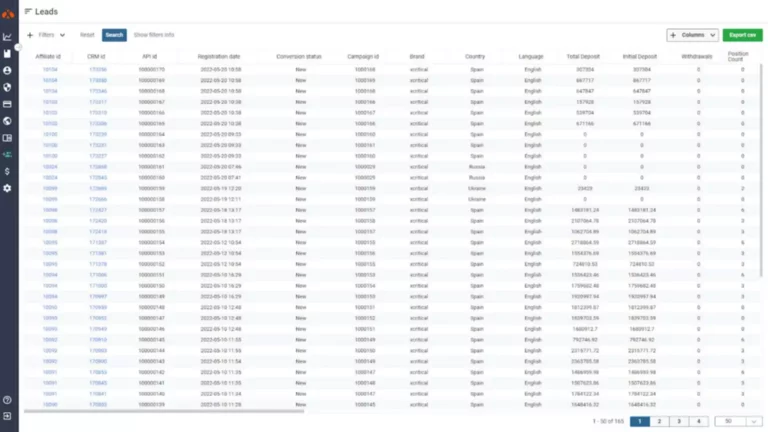Content
Communicate with your existing partners early and often about the reshaping of the https://www.xcritical.com/ tier program, potentially using this as an opportunity to collect further participant insights. Before rolling out your partner tiers broadly, get in touch with your top partners and ask for their input.Then, work with all active partners to identify which tier they land in, and communicate openly about how that will impact your engagement. For example, for some partners, you may allocate fewer resources, while others may be excited to hear that they’ll have access to additional resources. You’ll learn more about the most effective partner activities over time, just as your partner program will evolve. You don’t want to cause confusion or have partners feel like you’re moving the goalposts.
The Partner Tiers Cheat Sheet: Benefits, Drawbacks, and Checklists
You want to save your most resource-intensive benefits for top tiers with the fewest partners. Just as you’ll be able to prioritize partners appropriately, you’ll be able to optimize the resources you spend on your partners. Whether you’re working on co-marketing campaigns or developing a new integration, you’ll need to leverage resources from the rest of the company. With tiers in place, you’ll be able to save the most resource-intensive activities for the highest-tiered partners. The sheer volume of data forex crm required to evaluate and execute supply chain decisions makes exception management an essential part of any CPFR solution.
Top Partner Programs to Model Your Tiers On
The Tier 1 supplier relies on multiple Tier 2 suppliers for key components and parts required to produce the ECUs. One critical component, let’s say a specialized microcontroller, is supplied by a Tier 2 supplier. Consider a multinational automotive trading partner collaboration company with Tier 1, Tier 2 and Tier 3 suppliers involved in the production of a specific vehicle component, such as electronic control units (ECUs). Today’s supply chains are more interconnected than ever; one glitch can harm the entire ecosystem.
success factors to implement multitiered supplier collaboration
They can lead to delays in decision-making, disruptions in trading activities, and even dissolution of the partnership. Decision-making in a partnership can also be a challenge if there is a lack of clear communication among the partners. This can lead to misunderstandings and conflicts, which can negatively impact the partnership’s trading activities. This can be a challenge if there is disagreement among the partners about a particular trading decision. It can also be a challenge if one partner has more knowledge or expertise in a particular area of trading than the others.
For more information about PLOS Subject Areas, click
For instance, the day-to-day operators end up receiving confusing guidance or conflicting priorities from partner organizations. As new technologies, regulations, and economic realities emerge, trading partners will need to be nimble and proactive in their approach. Failing to do so can result in costly fines, legal troubles, and reputational damage. That’s why it’s so important to choose trading partners who are committed to ethical and compliant business practices.
The goal is to catch potential issues early and nip them in the bud before they become major problems. These agreements are crucial for ensuring that both parties are on the same page and can work together smoothly. The S&P Midcap 400/BARRA Value is a crucial index in the world of trading, providing a comprehensive and reliable benchmark for mid-cap companies in the United States.

Graph presents Player 2 transfers by different relationship types across treatments. The first set of bars represents Player 2 transfers in Market PE and the second set of bars represents Player 2 transfers in Market IE. Within each set of bars, from left to right, the bars represent negative relationships, positive relationships, and subject pairs with no trading relationships.
Our goal is to help empower you with the knowledge you need to trade in the markets effectively. Track how your partners move up or down in tiers to evaluate the causes and identify possible trends. If your partner’s tier isn’t working well for their needs, figure out if it’s a “tier problem” — meaning you need to evaluate the tiering requirements for possible modification — or a “mobility problem” — meaning you don’t provide enough room, resources, and support for growth. From the get go, you should gather intel about what your partners value from your company ahead of time so you can build those components into your tiering program at launch. Then, continue to get feedback from current and new partners on what’s working and what’s not.
Partner organizations must acknowledge that the scope of the relationship is likely to shift over time. This will be the case whether the partners are in a single- or multiasset venture, expect that services will be shared, anticipate expansion, or have any geographic, regulatory, or structural complexities. Accepting the inevitable will encourage partners to plan more carefully at the outset. For example, during negotiations, the partners in a pharmaceutical partnership determined that they had different views on future demand for drugs in development. Instead, the partners designated a formula by which financial flows would be evaluated at specific intervals to address any changes in expected performance.
One such way to promote top performers is to create opportunities to host webinars or collaborate on partner marketing campaigns. This simultaneously benefits your top-tier partners while inspiring lower-tier partners to advance. Plan to highlight opportunities to advance in all of your communications with partners. It can help to automate this outreach so your partners always know what waypost is just out of reach.

With a PRM you can automate communications with partners, alerting them of any potential tier changes and opportunities for improvement. Through the included documentation library, you can make tier documentation easily accessible to all partners and marketing resources accessible to partners based on their tier. Many overly ambitious projects have had to be abandoned or scaled back — to co-managed inventory alliances or joint forecast projects — because one or both trading partners did not fully understand the obligations. Even when two partners seem ideally suited and share similar cultural values, unforeseen circumstances like organizational and market changes can disrupt CPFR relationships. Choosing your partners wisely and carefully evaluating the compatibility of people, process and technology are all keys to success. For this reason, CPFR is most likely viable only for your top-tier trading partners.
Trust is often dichotomized into generalized trust (i.e. trust in strangers) and interpersonal or individualized trust (i.e. trust in known individuals). In this study, we focus on interpersonal trust, as it is what emerges or is eroded when market participants directly trade with one another in market environments. We define reciprocity as a person’s internal motivation to respond favorably or unfavorably to another person’s action (even absent of material gains).
Trust facilitates market exchanges by lowering transactions costs since it would be costly (perhaps prohibitively) to address all possible contingencies of a transaction. But less attention has been given to whether or not market transactions can facilitate the emergence of trust. Specifically, the potential of markets to allow for the emergence of social relationships characterized by trust and reciprocity has been relatively understudied. A supplier advisory board (or council) serves as a neutral and collaborative forum for the exchange of ideas between the host company and a group of strategic suppliers. Such boards are widely used by companies with mature procurement organizations, and they do so for a variety of reasons. A board may advise on key industry trends, risks, and potentially disruptive threats in the supplier ecosystem.
- At its simplest, joint planning can involve aligning on metrics and value sharing agreements.
- Swaps are a form of derivative contract which allows financial institutions to manage interest rate risk by buying contracts with installment payments based on interest rate differentials.
- We believe that a laboratory experiment where individuals engage in a market game with the possibility of defection followed by a trust game will be able to show that markets can promote the development of meaningful social bonds characterized by trust and reciprocity.
- Imagine being able to share your Z Wheels with friends, compete in contests, and even monetize your investment strategies.
- Below, we first describe the treatment with the bilateral, simultaneous offer market game that allowed exchanges to be more personal (Market PE).
Each succeeding stage is defined by increasingly higher levels of collaboration, integration, process maturity and technological sophistication. The term trading partner can be applied to almost any combination of suppliers, manufacturers, distributors or retailers. CPFR itself is an outgrowth of earlier collaboration efforts like JIT (just in time), VMI (vendor managed inventory) and others. Bringing different business cultures together can be challenging, given partners’ varying communication styles and expectations. The good news is that there are a range of tools—among them, financial models, key performance indicators, playbooks, and portfolio reviews—companies can use to help bridge any gaps.
Player 2 transfers to negative relationships are statistically no different transfers to positive relationships in Market IE. Player 1 transfers to negative relationships are statistically no different than transfers to positive relationships in Market IE. Player 2 transfers to negative relationships are smaller than transfers to positive relationships in Market PE. Player 1 transfers to negative relationships are smaller than transfers to positive relationships in Market PE. Player 2 transfers to negative relationships are identical transfers to positive relationships in Market IE.
